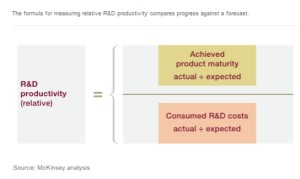An all-in-one, one-for-all formula to determine R&D’s productivity can help companies see how well the function is performing. The question of R&D’s productivity has long resembled a Gordian knot. Look nearly anyplace else in today’s corporations, and there’s far less difficulty measuring productivity and performance. In manufacturing and logistics, you can get a sense of things just by looking around the production floor, the inventory room, or the loading dock. Even the performance of the advertising budget—once famously opaque—is now, thanks to digital technology, much easier to see.
But the R&D department provides fewer clues. There’s no flow of tangible goods through the process, for one thing, but rather a stream of ideas and concepts that resist the efforts of efficiency experts and innovation gurus alike. In the face of this difficulty, most companies fall back on a few well-worn approaches: R&D as a percentage of revenue, the ratio of new products to sales, or the time it takes for new products to reach the market. None of these really gives a good idea of how well the R&D function is performing, either overall or by team—nor is it clear why (or when) any given project might suddenly prove a failure though it had earlier shown every promise of success.
We have endeavored to address this long-standing puzzle. We may not have answered it definitively, but we have developed a formula we believe will be useful to any company that wants to establish and maintain a comprehensive and transparent overview of the R&D organization’s many platforms, hundreds of projects, and thousands of engineers, technicians, program managers, and lab workers. Just as Alexander the Great is said to have undone the Gordian knot by the simple expedient of slicing through it with his sword—rather than trying to unravel it by hand, as others had attempted to do—our formula makes relatively quick, simple work of a knotty problem.
This formula takes a novel approach to measuring R&D outcomes: multiplying a project’s total gross contribution by its rate of maturation and then dividing the result by the project’s R&D cost. Since proposing this idea, we have worked with several companies to test it and introduced it to a diverse group of approximately 20 chief technology officers (CTOs) and other senior executives in a roundtable setting. So far, the formula demonstrates several virtues. First, it’s a single metric rather than a collection of them. Second, it aims to measure what R&D contributes within the sphere of what R&D can actually influence. Finally, by measuring productivity both at the project level and across the entire R&D organization (the latter through simple aggregation), it endeavors to speak to the whole company, from the boardroom all the way to the cubicle. Refinements to the approach may be necessary, but for now at least, the formula seems to represent an advance in measuring R&D’s productivity and performance.
by Eric Hannon, Sander Smits, and Florian Weig
About the authors: Eric Hannon is an associate principal in McKinsey’s Frankfurt office, Sander Smits is a principal in the Amsterdam office, and Florian Weig is a director in the Munich office.
More: www.mckinsey.com
